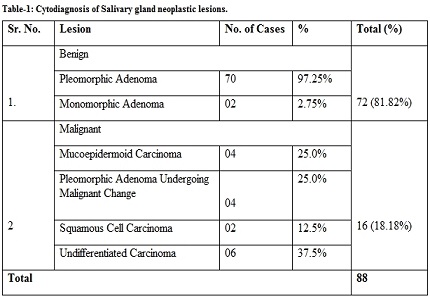Comparative study of Cytodiagnosis of salivary gland neoplasm with histopathology
Abstract
Introduction: FNAC is the largest tool in diagnostic pathology. Cancer is the leading cause of death in India. Salivary gland neoplasms accounts for 6% of all head and neck tumors. There are many advantages of FNAC. But in head and neck lesions, it is easily accessible, having excellent patient compliance, also a minimally invasive procedure and helping to avoid surgery in non-neoplastic lesions.
Aims and Objectives: To test the utility of FNAC, to establish the perfect diagnostic accuracy of cytology before operative procedure and also by comparison with histopathology diagnosis and also to establish the sensitivity and specificity of this technique in neoplastic lesions.
Material and Method: The present study was undertaken in the Pathology Department of GMERS medical college and hospital, Sola-Ahmedabad, Gujarat during the period of January 2015–June 2016.
Results: Among all salivary gland neoplasms, pleomorphic adenoma was the most common salivary gland neoplastic lesion (79.55%). Mucoepidermoid carcinoma was the commonest malignancy seen. Majority of malignancies were present in the 51-60 years age group (62.50%). The mean age of salivary gland neoplasms was found to be 41.59 years. Male to female ratio was found to be 1.2:1 and in malignant lesions the male to female ratio was 3:1.
Conclusion: Even though excision biopsy remains the gold standard for diagnosis of the salivary gland neoplastic lesion, cytological study can also establish the diagnosis of the majority of salivary gland neoplastic lesions and can be recommended as an adjunct and prior to histopathology.
Downloads
References
2. Abrari A, Ahmad SS, Bakshi V. Cytology in the otorhinolaryngologistsdomain- a study of 150 cases, emphasizing diagnostic utility and pitfalls. Ind J Otolarnyngol Head Neck Surg 2002;54(2):107-10.doi: 10.1007/BF02968727. [PubMed]
3. Martin H, Ellis EB. Biopsy of needle puncture and aspiration. Ann Surg1930;92:169-81.PMC1398218. [PubMed]
4. Platt JC, Davidson D, Nelson CL, Weisberger E. Fine-needle aspiration biopsy: an analysis of 89 head and neck cases. J Oral Maxillofac Surg. 1990 Jul;48(7):702-6; discussion 706-7. [PubMed]
5. Johnson JT, Zimmer L. Fine needle aspiration of neck masses. Available from: URL:http://emedicine.medscape.com/article/1819862-overview.
6. Assessment. In: Watkinson JC, Gaze MN, Wilson JA, eds. Stell&Maran's Head and Neck Surgery. 4th ed. Oxford: Butterworth Heinemann; 2000. p. 21.
7. Gray W, McKee GT. Diagnostic Cytopathology, 2ndedi. London: Churchill Livingstone; 2003.P. 6.
8. Rao YN, Gupta S, Agarwal SP. National Cancer Control Programme: Current Status & Strategies. In Agarwal SP, ed. Fifty Years of Cancer Control In India. Dir Gen of Health Services, MOHFW, Government of India, 2002;41-7.
9. Ahluwalia H, Gupta SC, Singh M, Gupta SC, Mishra V, Singh PA, Walia DK. Spectrum of head and neck cancers at Allahabad.JOtolaryngol Head Neck Surg2001;53(1):16-20.doi:10.1007/BF02910972. [PubMed]
10. Mehrotra R, Singh M, Gupta RK, Singh M, Kapoor AK. Trends of prevalence and pathological spectrum of head and neck cancers in North India. Indian J Cancer. 2005 Apr-Jun;42(2):89-93.
11. Fine needle aspiration cytology: Diagnostic principles and dilemmas: Gabrijelakocjan. Page:2.
12. Amedee RG, Dhurandhar NR. Fine-needle aspiration biopsy. Laryngoscope. 2001 Sep;111(9):1551-7. [PubMed]
13. Silverberg SG, DeLellis RA, Frable WJ, LiVolsi VA, Wick MR, editors. Silverberg’s Principles and Practice of Surgical Pathology and Cytopathology. 4th ed.NY: Churchill Livingstone – Elsevier; 2006. p. 22.
14. Firat P, Ersoz C, Uguz A, OnderS.Cystic lesions of the head and neck: cytohistological correlation in 63 cases.Cytopathology. 2007;18(3):184-90. DOI: 10.1111/j.1365-2303.2006.00400.x
15. Stewart CJ, MacKenzie K, McGarry GW, Mowat A. Fine-needle aspiration cytology of salivary gland: a review of 341 cases. Diagn Cytopathol. 2000 Mar;22(3):139-46. [PubMed]
16. Cristallini EG, Ascani S, Farabi R, Liberati F, Maccio T, Peciarolo A et al, Fine needle aspiration biopsy of salivary gland, 1985-1995. Acta cytol. 1997;41(5):1421-5. DOI: 10.1159/000332853. [PubMed]
17. Shafkat Ahmad, Mohainmad Lateef, Rouf Ahmad, Clinicopathological study of primary salivary-gland tumors in Kashmir. JK-practitioner 2002;9(4):231-3.
18. Khandekar MM, Kavatkar AN, Patankar SA, Bagwan IB, Puranik SC, Deshmukh SD et al, FNAC of salivary gland lesions with histopathological correlation. Indian JOtolaryngol Head Neck Surg 2006;58(3):246-8.doi: 10.1007/BF03050831.
19. Yang GC, Kuhel WI. Uncommon tumours of the salivary gland in fine needle aspiration biopsies: A surgeon’s perspective. Acta Cytol, 1997;41:1015-22.DOI:10.1159/000332782.



 OAI - Open Archives Initiative
OAI - Open Archives Initiative


